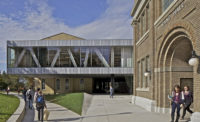 Andres Lepik Photo:Courtesy the Museum of Modern Art |
Andres Lepik, a German curator and historian, joined the Museum of Modern Art as curator of contemporary architecture on July 1. He becomes the newest member of the Architecture and Design Department, headed by Barry Bergdoll, who was appointed last summer.
Lepik most recently served as chief curator of the 20th- and 21st-century architecture collection at the Kunstbibliothek, in Berlin. Working in that capacity since 2004, he staged a series of small exhibitions that explored the designs of Berlin-based architects who have had commissions around the world but not in Berlin. According to Lepik, the show provided a platform for reputable firms, such as Barkow Leibinger and Juergen Mayer, “to creatively engage with their own city.”
A widely published writer, Lepik recently released a monograph on Barkow Leibinger Architects, and a book on skyscrapers. Before joining the Kunstbibliothek, he was a curator and assistant to the general director at the National Gallery, in Berlin. His seminal shows there included Renzo Piano, in 2000, Mies in Berlin, in 2001, and Content/Rem Koolhaas, in 2003-2004. The Mies show was undertaken in partnership with the popular exhibition at MoMA, on which both Lepik and Bergdoll worked together.
Lepik’s transition to museums from academia was somewhat fortuitous. While he was working on a Ph.D. about Renaissance architectural models at the University of Augsburg during the early 1990s, the Altes Museum was coincidentally planning an exhibition on the same themes treated in his dissertation. Altes recruited Lepik to help curate that show and he has been affiliated with museums ever since.
Though his MoMA tenure began this month, Lepik remains in Berlin until August 15. His first exhibition is scheduled for mid 2008 and will draw from the museum’s permanent collection. He plans to spend his first year building relationships with architects as well as researching potential acquisitions for the collection.
Lepik comes to MoMA without a specific agenda, but he is admittedly interested in the urgency of sustainable design and in architects practicing outside of the celebrity spotlight. “Strengthening the collection is a very important issue to me,” he says. “Not as a way to promote certain architects to make stars of them, but rather to establish what is worth investigating about architecture today, and to figure out what is representative of a certain style.”





